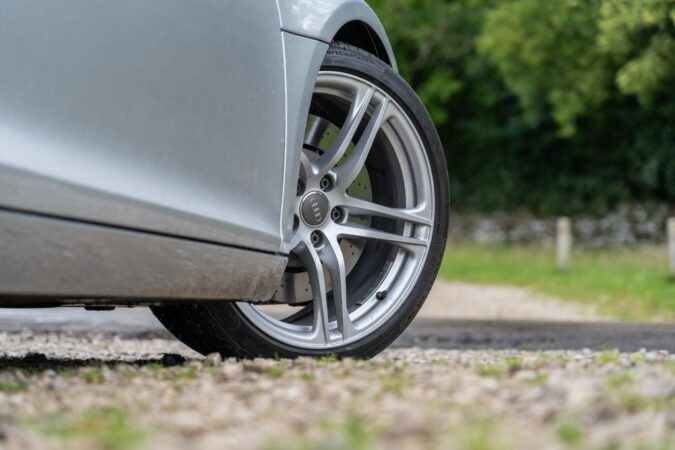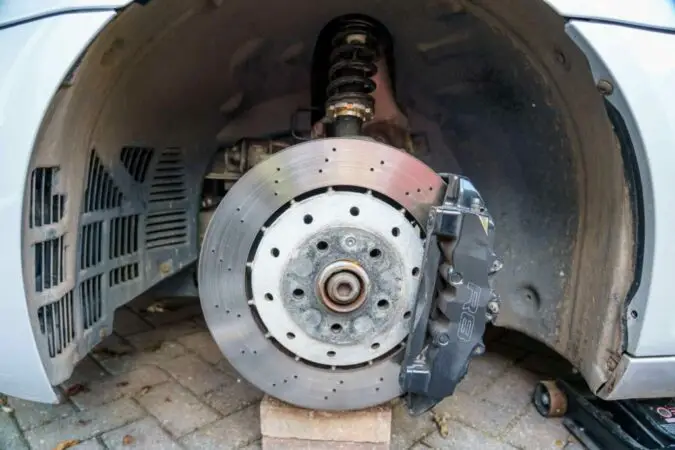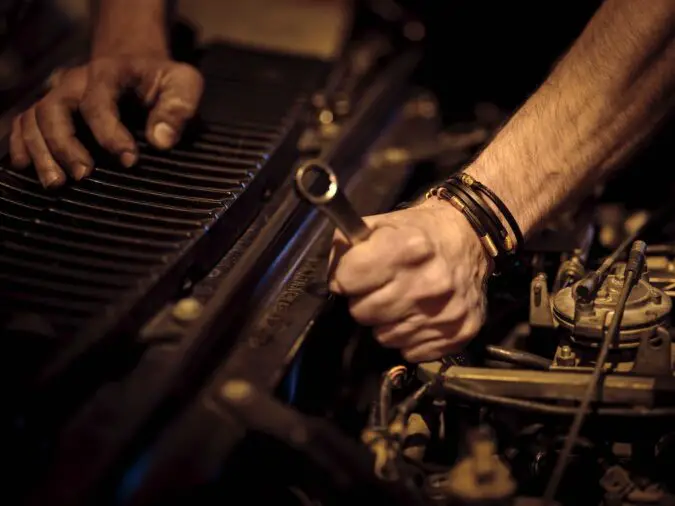Every vehicle features a suspension system where the wheels connect to the rest of the vehicle. A suspension system has to make the vehicle stable when steering, keep the passengers comfy, and maximize contact between the road and the tires. A vehicle’s suspension system plays a deciding role in the car’s overall performance. The MacPherson strut might be an old invention but it’s still relevant today.
Several parts and components make up a suspension system, such as tires, linkages, steering system, shock absorbers, bushings, bearings, joints, and springs. Much like everything else in a car, not all suspension systems were built the same.
The MacPherson strut was designed by Earle S. MacPherson in the late ‘40s. Despite being simple, this suspension system is still in use in many modern vehicles, like the Ford Mustang. The MacPherson strut is available in multiple designs, but the basics remain constant.
- History
- What Is A Strut?
- Working Mechanism
- Variations
- MacPherson Strut Vs. Double Wishbone
- MacPherson Strut Vs. Coilover
- Replacement
- Replacement Prices
- FAQs
History Of The MacPherson Strut
Earle S. MacPherson, the developer of this particular component, was an American automotive engineer who came up with the concept in 1945. His variant was heavily influenced by the works of his peer/rival, Guido Fornaca, and Cottin-Desguottes. Fornaca was an employee at FIAT while Cottin-Desguottes was a French automaker who designed a leaf-spring-based design meant to unify the suspension and steering rod.
Deriving influence from these earlier designs, MacPherson started to create his system from a shock absorber and single assembly coil spring. The MacPherson strut was used for the first time in the 1949 Ford Verdette before being used in the Ford Zephyr and Consul, both released two years later.
Originally incorporated in both the rear and front wheels, the rear end was excluded due to the presence of the steering rod. Most modern cars feature a torsion beam suspension and a MacPherson strut front suspension pairing, although a rear strut is available in some cars.
What Is A Strut?
Similar to a shock, a strut’s job is to dampen the vehicle’s coil spring’s movements. This prevents the ride from getting overly bouncy.
However, struts are quite different from shocks in many ways. The first difference is that a strut is a component of the car’s body, unlike the shock. Heavier vehicles, such as large trucks, feature shocks, whereas most lighter cars use struts.
MacPherson Strut Diagram
MacPherson struts can technically be used for all 4 wheels, but are generally employed on the car’s front suspension. In effect, this assembly performs several key functions. It makes a steering pivot, provides a stability point, and naturally, absorbs shocks.
1. MacPherson Strut Components
A MacPherson strut assembly can only work when all its internal components are working in tandem. Every component has a purpose, and it helps to know a bit about each one.
2. Shock Absorbers
This component is what people think of when they hear the term “strut.” When people say that the strut has to be replaced, they mean the shock absorber. Most struts work on pressurized gas.
In the MacPherson strut, in particular, the strut is where the camber angles and caster can be adjusted. You can also regulate the damping rate when using performance struts.
3. Coil Springs
Coil springs assist in absorbing all the bumps on the road. Without the struts, the springs would provide a bumpier ride. Springs and struts are occasionally substituted with coilover. We will also talk about MacPherson struts vs. coilover in a future section.
4. Lower Control Arms
Only one lower control arm is used in the MacPherson system. This plays a role in preserving space. The control arm links the unibody to the wheel and allows it to move up and down using the ball joint.
5. Steering Linkage
The steering linkage provides a way to drive the front wheels. A big benefit of the MacPherson strut assembly is its compatibility with a wide variety of steering angles. This makes it a significantly better choice for performance driving.
Common MacPherson Strut Variations
As we mentioned before, the MacPherson strut has one fundamental design, and all the variants serve the same purpose. However, some changes have been made to the design to meet the changing needs of the time.
1. Control Arms
A lower control arm has been a consistent feature within a MacPherson strut system (it would become a double-wishbone suspension if there was an upper control arm). The shape of the control arm might differ. The majority of control arms are either “L” shaped or “A” shaped. Manufacturers usually choose between either of the two based on the other design elements of the vehicle.
2. Sway Bars
Another great benefit of the MacPherson strut system is that it lets the front wheels move independently, devoid of each other’s influence. That can be a weakness in some situations though, and a better connection between the wheels is more beneficial anyway.
A sway bar joins the right and left parts of the front suspension. They help to provide stability and stop body rolls. Although sway bars are common inclusions to a MacPherson strut assembly, they can also be added later on.
3. Strut Tower Brace
The job of a strut tower brace is the same as a sway bar’s, but the tower brace does it by joining the struts’ tops. This modification is rather easy and can be performed from under the hood.
A few performance vehicles featuring the MacPherson strut system will come with a strut tower brace. One example is the Bullitt Mustang.
MacPherson Strut Vs Double Wishbone
Various kinds of suspension systems are designed for use in vehicles. The two most commonly used include the double wishbone suspension system and the MacPherson suspension system.
Each system has to offer a different set of advantages and disadvantages. Depending on the type of car you drive, you have to decide which system will work the best for you.
MacPherson Suspension
Now, let’s look at the advantages of MacPherson suspension that it generously offers, and the disadvantages that you should know of.
Advantages
Struts in a MacPherson suspension system work effectively to keep the vehicle flat against the road. As they do not take up a lot of room, they leave more space for the passengers. Moreover, vehicles using a MacPherson suspension assembly are lighter as they do not have the additional unsprung weight. Thanks to the reduced weight, the vehicle can accelerate faster.
A vehicle like this is more comfortable to drive as well. And if you are concerned about the budget, a MacPherson suspension system is generally priced lower than its double-wishbone counterpart.
Disadvantages
MacPherson suspension systems have lengthy vertical assemblies to them. You might run into some problems if you want to lower your car for some reason. Anyone driving a sports car or race car will not prefer this kind of suspension as those kinds of cars typically run lower.
Moreover, since it has a vertical nature, your vehicle’s tires will not touch the roads as much when making turns. This, in turn, limits overall control over the vehicle.
Double Wishbone Suspension
You should also be aware of the advantages and disadvantages that Double Wishbone suspension offers.
Advantages
The double wishbone suspension features lower control and vertical upper arms that enhance the negative camber. Therefore, the driver experiences better stability when driving as the tires are more in contact with the road. Moreover, the wheel alignments stay consistent along with your steering.
As a result, you have better control over your vehicle when driving, regardless of the stress the car experiences.
If you want a suspension that lets you control your car with consistency and stability, you cannot go wrong with the wishbone suspension.
Disadvantages
The only “problem” we found with the double wishbone suspension is its inflated price tag. Given how complex this system is in comparison to the MacPherson one, the increased prices are justified.
In addition, numerous parts and components are working inside a double wishbone suspension assembly. If any part were to get worn out or go bad, the entire system would stop working entirely. Car owners will have to shell more money into repairs and maintenance.
MacPherson Strut Vs Coilover
Struts and coilovers are sometimes used interchangeably in conversations about automobiles. Although similar, these parts are not the same.
Coilovers are one type of struts with the spring coiled over and around – all the way to the top. For the primary difference, it is notable that coilovers usually offer extra dampening, adjustability in ride height, and give users the power to change springs and get a more-custom rate.
We like to consider struts OEM options different automakers like installing their vehicles, while coilovers are typically reserved for tuner cars or high-performance variants.
MacPherson Strut Replacement
Is your car a bit too bouncy when you move over bumps on the road? Exit the car and push down on all of its corners. If it bounces three times and above, it’s time to replace the struts or shocks on that corner.
MacPherson struts are amongst one of the hardest parts to replace by hand, but the job is doable. All you need is a little patience and the willingness to navigate through basic issues. You will get a sign that it’s time to get involved physically.
If the front shocks or struts are worn, the vehicle will not steer smoothly over bumps as the wheels are not always touching the ground. Conversely, if the back ones go bad, the vehicle feels like it’s being moved from the back when you come across a bump on the road.
If you are unlucky and both sides tap out, your downtown car cruise will feel super unstable and bouncy, not to mention the stress of making freeway curves. Either way, if you choose to do the job by yourself, you can save a ton of money. Plus, with the saved money you could get yourself some fancy performance struts for your car. Think of the trade-off here.
However, it’s important to maintain caution as working with springs is dangerous. Maintain strict safety guidelines at all times.
As you can see from a MacPherson strut diagram, the assembly is rather straightforward. Your job is to unscrew the top mounts, take out the bolts holding the struts in place, and remove the entire thing in one piece.
Let’s start.
Step 1: Loosen The Nuts
While the car is still on the ground and you are still contemplating the process in your head, unfasten the wheel lug nuts along with the 3 or 4 nuts holding the strut’s top and frame together. Don’t forget to loosen the big nut securing the spring on the strut.
Important note: You have to loosen the nuts, not remove them. As the vehicle is still under load you can end up seriously injuring yourself by removing everything in that state. Why did we work on these nuts in this position, you ask? These nuts are difficult to unfasten when the vehicle is off the ground.
Now that those nuts are out of the way, jack the vehicle’s side off the ground and place it on the jack stands securely. Chock the wheels on the other side of your car to make sure they do not roll down when you are working. Use frame cross-members, jacking points, and similar sturdy components to position the jack stands and jack.
Do not depend on a jack for this process – particularly a hydraulic one. This is a job for a jack stand. Made of metal, jack stands do not move and make it safe to keep the car off the ground. Also, do not use suspension parts to jack up the car.
Step 2: MacPherson Strut Spring Compressor
The jack stands/jack could slide on them (since they move), and it will be impossible to remove the struts from your car if the suspension arms do not move when you remove the mounts. After you have safely raised the car and supported it properly, walk around your vehicle and give every corner a brief jiggle to ensure the position is stable.
Again, unfasten the top nut before you remove the strut from the car. The top nut will pose a challenge for most DIY-ers. Once you remove the strut and find that you cannot disassemble the system even though you spend a long time compressing the springs, it will already have been too late. The reason is the top nut was too tight.
Learn how to compress a strut with a coil compressor and MacPherson strut with this video here.
Do not take off the top nut entirely because that is dangerous on its own.
Step 3: Detach All From The Strut’s Bottom
To reach the bottom section of the strut and loosen it, you normally have to take out the rotor and brake caliper. In most scenarios, you must unfasten the brake hose to remove the caliper from the small bracket connecting it to the strut. As a result, you will have to empty the brakes once the whole job has been finished.
After you disconnect the line, reattach it while you work on the other components so that i) dirt does not get into the brake fluid gallery of the calipers, and, ii) brake fluid does not squirt all over the place. Apply some lubricant to the bolts that have to be removed. Suspension elements are always in contact with the road salt and dirt and thus, prone to stickiness. You must remove whatever big nuts/bolts connecting the knuckle/hub to the strut, and you might have to detach a sway bar link in the process.
Important note: Make sure to check how the alignment parts were oriented. Since they play a role in suspension geometry, you cannot get that wrong. That being said, you will have to get the alignment done either way, but it’s best not to drive a vehicle with the tops of the wheels protruding.
Step 4: Loosen The Top Of The Strut
Hold the strut with your free hand when you remove the three or four nuts securing the top of the strut. The strut should not fall out of the vehicle’s bottom onto the helper/foot. Once free, the strut may be worked on with a pry bar to remove suspension parts blocking the way so it can slide out of the tower.
No need to force anything. If you must, take out the tie rod ends until there is enough space to remove the strut assembly. You can get a lot of leverage in these DIY automotive processes if you have basic problem-solving capabilities, and this is one of those places.
Now that the strut assembly is out, you will require a special toolset to compress the spring. Essentially, it is a pair of hooks used to secure the hold and fasten it with large screws. These bits can be risky if you do not handle them properly, or if they have deteriorated.
Position the hooks as far as possible on the spring so that it has enough room to compress and relieve pressure. The two screw/hook tools must be on opposite ends of the compression spring. Placing them too close to one another will not work. Fasten them bit by bit, first on one side, then back and forth.
Once the spring has been compressed enough (you will start to notice a small crevice between one or two of the mounting plates and the spring), you can unfasten the top and nut and remove the top plate. Observe the orientation at this stage. The spring must be oriented in its original position when you mount it once again but on a new strut tube.
Step 5: Final Touch To The Strut
Keep the rubber dampers close – they go between the mounting plates and the spring. Forget these and your vehicle’s suspension will make incessant clanking noises the entire journey.
Once the assembly is back together, secure the top nut and unfasten the compressor screws. When the MacPherson strut spring compressors are removed, you can place the strut back on the assembly of the vehicle. The top once goes first, with the safely secured mounting nuts so that you can move the rear around and mount it right. Now, secure the bottom components.
After everything is in its original position, secure everything to the correct torque (you should be able to find that online for any vehicle). Go back and check the connections again to ensure they are bolted in place.
With the struts placed back in the vehicle, recheck everything before bleeding the brakes (if you have to detach the brake lines to remove/place the struts). Then, change the wheels and bring the car down. Once the car is back on the ground, fasten the lug nuts to the right torque and tighten the top nut and strut top mount nuts.
Is everything done? Remembered to check and re-check the elements we mentioned above? Great. Take your car for a spin (with the speed on low). If everything works fine, congratulations! The MacPherson strut has been successfully replaced.
MacPherson Strut Prices
On average, MacPherson strut replacement will cost you anywhere between $450 to $900 for each pair. A single strut assembly will cost around $150 and $300. The parts alone will set you back $300 to $600 while the labor charges can pile up to $300 for a pair.
MacPherson Strut Suspension – Facts:
- The MacPherson strut is a common type of front suspension used by mainstream car manufacturers worldwide.
- The suspension design is simple and based on a triangular structure formed by a control arm and a radius rod.
- The control arm locates the wheel laterally, while the radius rod stops it from moving fore and aft in the wheel arch.
- The MacPherson strut has a spring and damper unit mounted vertically or close to it, consisting of an enclosed cylinder that bolts to the top of the hub.
- The design is strong and versatile, making it easy to tailor for demanding usage, like track driving, and is also a cheap design to produce.
- The MacPherson strut works best with unibody chassis or monocoques, which have high relative rigidity between the strut’s mounting point areas.
- The MacPherson strut has seen various developments over the years, resulting in different interpretations of the design.
- Some cars now use a wishbone instead of the old control arm and radius rod combination.
- The MacPherson strut is a good system used by renowned car brands like BMW and Porsche.
- Although there are stiffer options like the double-wishbone setup, the MacPherson strut remains a brilliant and effective way to combine strength, spring, and stability at a low manufacturing cost.
Bottom Line
For something that was developed in the ‘40s, the MacPherson strut’s continued relevance proves how amazing this system is. Although a bit complex to the newbie car enthusiast, this suspension system has much to offer once you get the basics down.
But given how this is only available in older cars for the most parts, you will not come across a MacPherson strut unless you are looking at a performance car or vintage vehicle.
Frequently Asked Questions (FAQs)
Here are some popular FAQs:
What Is A MacPherson Strut
A MacPherson strut suspension is a basic, independent suspension design featured by almost every mainstream automaker globally, generally for the front wheels. The design is a triangular shape divided into two parts: a radius rod and a control arm, forming a triangle.
How Much Does A Strut Spring Compressor Cost
For entry-level professional tools, a strut spring compressor will cost between $50 and $250.
Why Does BMW Use A MacPherson Strut
The primary reason behind this suspension system’s popularity is the cost. They are less expensive than their double wishbone counterparts and relatively simpler to work around.
What Are The Types Of Suspension Components
There are 3 basic kinds of suspension components: springs, shock absorbers, and linkage.






